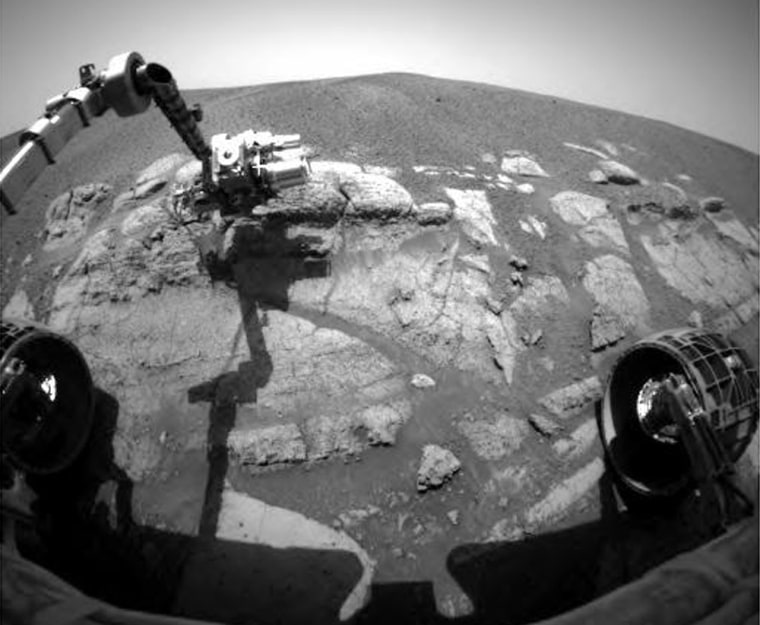Now that the age of commercial spaceflight has begun, is the sky the limit?
Is NASA, which hasn't gotten a manned spaceship off the ground since last year's Columbia tragedy, starting to look like a dinosaur among the furry mammals?
Do the wildly successful missions to Mars and Saturn show that robots are the ones that really have the "right stuff" when it comes to planetary exploration?
The past year's space achievements raised many questions — but fortunately, brought many answers as well:
- We now know it's possible for private companies to send people into outer space and bring them safely back again.
- We now know that areas of Mars were once covered with water, and could have provided places for life to develop.
- We now know the White House and congressional leaders are willing to put their money where their mouths are, in order to push into the space frontier once again.
When you put it all together, there's more to look back on this year than there has been since 1997, when Mars Pathfinder was the star of MSNBC.com's first "Year in Space" roundup. (To refresh your memory, you can look back on 2002 and 2003.)
We've put together five top space stories for 2004, and five trends to watch in 2005. It's up to you to pick the top contenders, using the admittedly unscientific Live Vote at right. If you have a write-in vote — or even if you just have something you need to get off your chest about the state of space exploration — you can send e-mail to the Cosmic Log in-box. We'll publish a selection of your responses after the first of the year.
2004's top stories

• Marvels at Mars: Missions to the Red Planet are almost always the top vote-getters in the "Year in Space" poll — doubly deservedly so in 2004, when surface operations on Mars extended throughout an entire Earth year for the first time in history. The Spirit rover's early problems tested NASA's mettle, then the Opportunity rover's interplanetary "hole in one" set the stage for unprecedented findings about Mars' watery past.

• SpaceShipOne's rise: The privately funded rocket plane's three nail-biting trips to the edge of outer space rekindled the spirit of the space effort's early days and proved that governments no longer had a monopoly on spaceflight. Comparisons to the achievements of Kitty Hawk were in abundance — and following up on the success of his "carefree re-entry" design, aerospace genius Burt Rutan said he would devote the rest of his life to developing safe, affordable space travel.

• NASA's double vision: President Bush set a "new course" to the moon, Mars and beyond in a January speech, and the space agency retooled itself for exploration. That farsighted 2020 vision may be sharp, but NASA has had more trouble with close work: Returning the shuttle fleet to flight has turned out to be more complex than expected, prompting NASA Administrator Sean O'Keefe to rule out shuttle servicing flights to the Hubble Space Telescope. Now O'Keefe himself is leaving the helm, and his successor may well reverse the decision.
NASA's problems and Rutan's success might lead some to see a public-private space rivalry brewing, and Rutan has certainly leveled sharp criticism at the agency he calls "Nay-Say." But the rise of a suborbital space industry, backed by legislation, could well lead to a symbiotic relationship with the farther-out exploration effort — where private markets and the public interest foster the next generation of space entrepreneurs and explorers.

• Saturn spectacle: How could anyone overlook a story seven years in the making? After a controversial liftoff in 1997 and an eventful cruise past Jupiter, the international Cassini spacecraft reached Saturn in July and immediately wowed astronomers with photos of the ringed planet and its moons. As the year drew to a close, Cassini unleashed a smaller probe to head for the mysterious, haze-shrouded moon Titan — but more about that later.

• New worlds: Astronomers found new frontiers in the search for planets and planetoids, with Sedna's discovery in the solar system's farthest suburbs. Scientists had thought there was a vast empty stretch in the region where Sedna was found, but thanks to this year's observations — including studies of extrasolar planets and protoplanetary disks — they now know that the universe is more crowded than they thought.
• And also: Stardust snaps a comet close-up in January ... Total lunar eclipses in May and October ... Venus makes rare transit in June ... Genesis probe goes splat in September ... Hypersonic flight goes right in November ... Missile defense system fails test in December ... Asteroid sparks brief "yellow alert" in December.
2005's top trends:
• Touchdown at Titan: The Huygens probe is due to parachute through Titan's atmosphere on Jan. 14. Will it splash down in hydrocarbon seas? Hit an icy continent? Fall to an unknown fate? The descent has its own drama, and if Huygens' final flight works out as astronomers hope, the mission will shed new light on an environment many scientists believe is much like early Earth once was. As a bonus, 2005 brings a whole year of science from Saturn, courtesy of Cassini.
• Return to flight ... or not? NASA is working toward its first post-Columbia shuttle launch in May or June. But how safe is safe enough? Will Discovery lift off even if mission planners aren't certain it could survive Columbia-level damage? Some say the shuttles should never fly again, while others say living with the risk is what space exploration is all about.
• Martian-go-round: How long can those plucky rovers survive on Mars? Could they still be on the job when NASA launches its next Mars mission in August? And let's not forget Europe's Mars Express orbiter, which detected traces of methane in the Martian atmosphere that may well hint at microbial life.
• China's second leap: The Shenzhou 6 mission, with two Chinese astronauts aboard, is scheduled for liftoff in September, following up on China's first manned space mission in 2003. Will the mission bring some surprises? Will it help fuel a new rivalry in human spaceflight, or will China turn out to be a new partner in space exploration?
• Flights of the Falcon: After months of delay, the upstart Falcon 1 rocket is due to make its maiden flight by mid-2005 with a military satellite as its payload. An even more significant launch of the beefed-up Falcon 5 could come late in the year, bearing an inflatable test module into space. Will this represent the next chapter in the private-sector space saga that began with SpaceShipOne?
• And also: Da Vinci's Wildfire rocket launches (or not?) in January ... Cosmos 1 solar-sail mission set for April ... Deep Impact takes aim at a comet in July ... Will there be an orbital space passenger in October?
